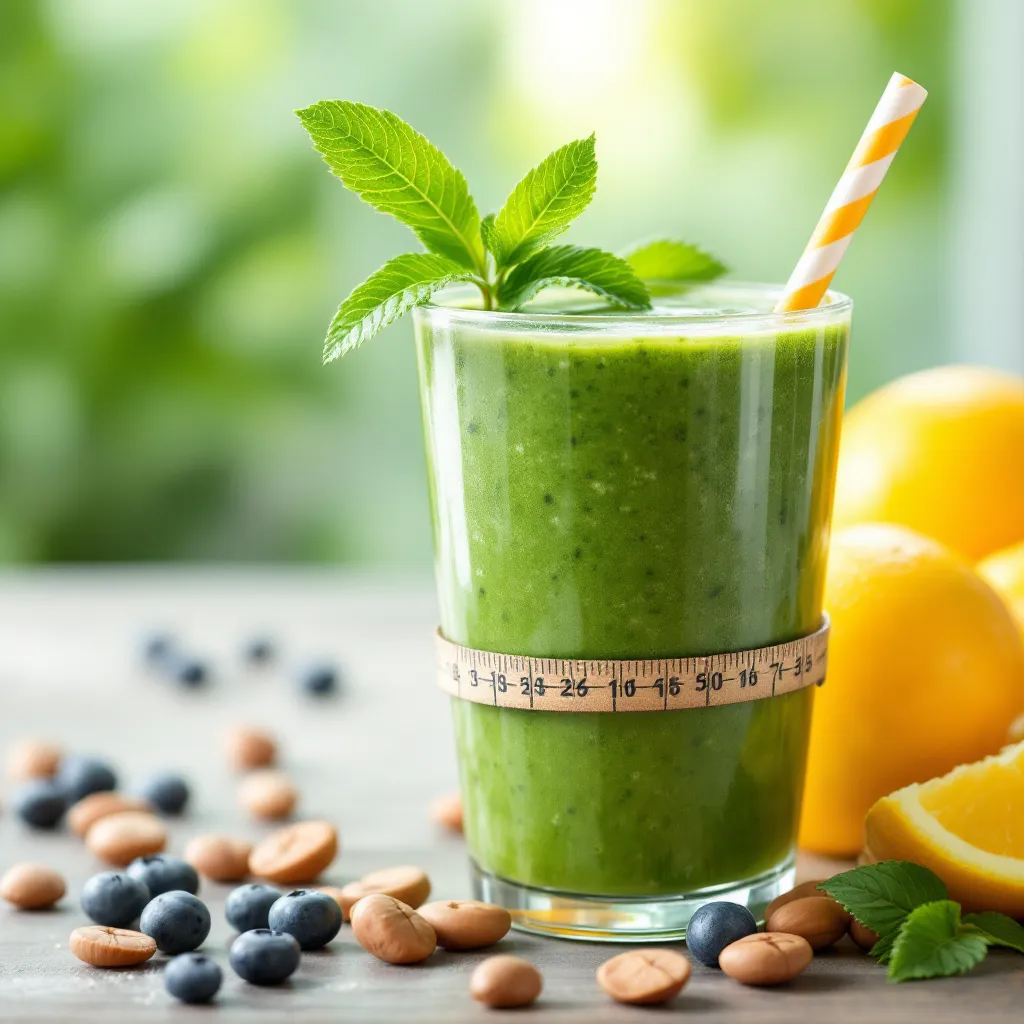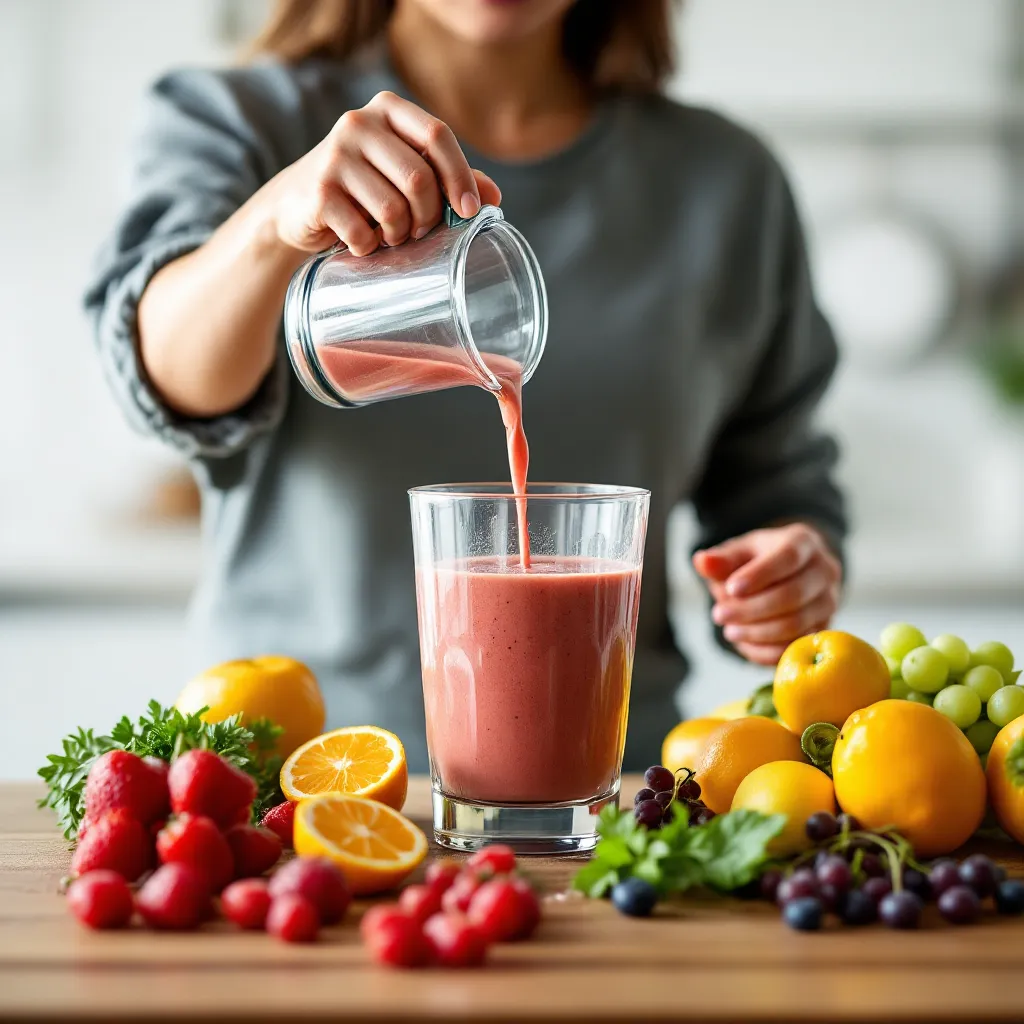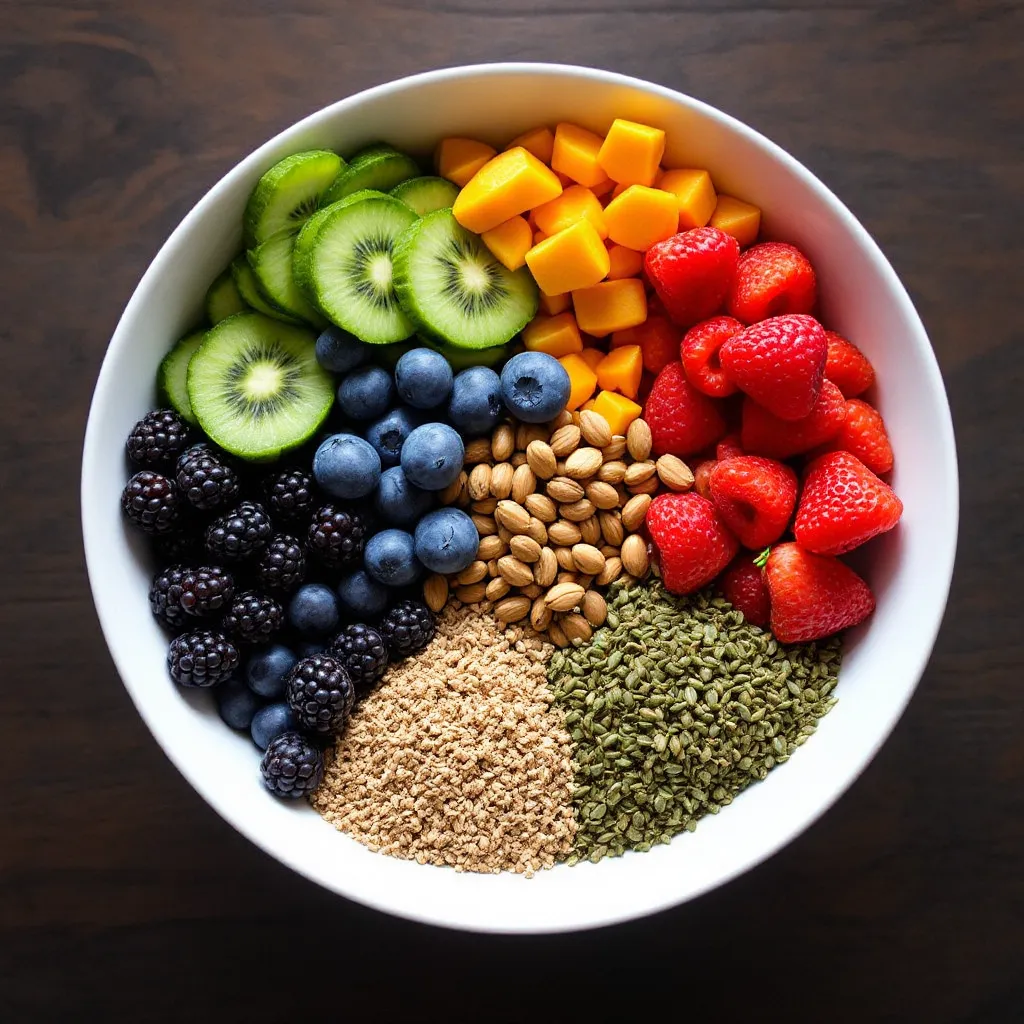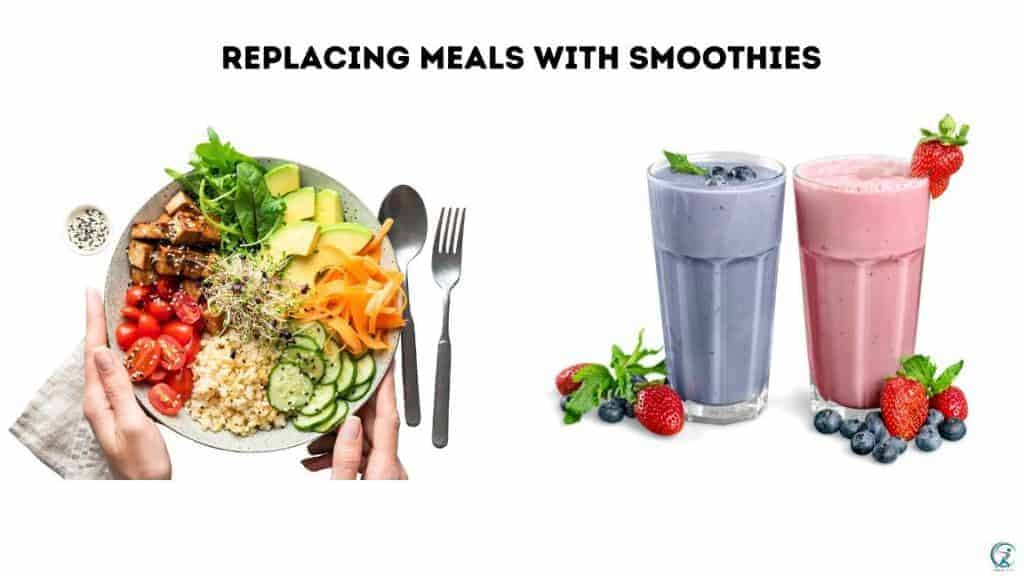How to lose weight by replacing meals with smoothies? It’s possible with the right plan.
This guide delivers science-backed, 2025-ready strategies. We focus on real results, not fads. Learn to build balanced, satisfying smoothies. Avoid common pitfalls. Achieve sustainable weight loss safely.
Let’s get blending!

Key Takeaways
- Meal replacement smoothies work by creating a calorie deficit, not magic.
- Balance protein, fiber, and healthy fats for satiety and nutrition.
- Replace 1-2 meals daily, never all three, for sustainable results.
- Choose whole, unprocessed ingredients over sugary additives.
- Aim for 30-40g protein and 8-10g fiber per smoothie.
- Short-term smoothie diets (3-7 days) can jumpstart weight loss.
- Long-term use requires careful nutrient planning and expert guidance.
- Transition back to solid food gradually to avoid rebound weight gain.
How Smoothies Can Help You Shed Pounds and Feel Amazing

Think of your body like a car. It needs fuel to run, right? But if you put in the wrong fuel or too much of it, the car won’t run smoothly. Food is our fuel. Healthy smoothies are like premium fuel – they give you the energy you need without the junk that makes you sluggish.
Here at Frenchyfab, I’ve helped countless people transform their bodies and their lives with simple, delicious smoothie recipes. It’s not just about losing weight; it’s about feeling more energetic, sleeping better, and just feeling good in your own skin. That is the main health benefit of replacing meals with smoothies and it helps you achieve your weight loss goals and maintain a healthy weight.
How do smoothies help?
- They fill you up. A good meal replacement smoothie is packed with fiber and protein. These two superheroes keep you feeling full and satisfied for longer, so you’re less likely to snack on unhealthy stuff. As a result, drinking smoothies for weight loss will help you reduce your daily calorie intake.
- They control your portions. It’s easy to overeat when you’re sitting down to a big plate of food. With weight loss shakes, the portion size is already set. No more guessing!
- They’re quick and easy. Let’s be honest; we all have busy schedules. Who has time to cook three healthy meals every day? Meal replacement smoothie recipes take minutes to prepare, making them perfect for busy mornings or a quick smoothie for lunch.
- They’re packed with nutrients. You can cram a ton of vitamins, minerals, and antioxidants into a single smoothie. Think of it as a multivitamin in a delicious, drinkable form, helping you with weight management.
Can I Replace Breakfast with a Smoothie for Weight Loss?
Yes. You can drink a smoothie instead of eating a meal. It works if the smoothie has balanced macros. Focus on protein, fiber, and healthy fats. This supports how to lose weight with meal replacement smoothies safely and effectively.
What Makes a Smoothie a Real Meal?
A meal replacement must satisfy. It can’t spike blood sugar. It must curb hunger. Use high protein meal replacement smoothies for weight loss to stay full longer. Add Greek yogurt, nut butter, or protein powder. Include leafy greens for volume.
- 20–30g protein per smoothie
- 5–10g fiber from veggies and seeds
- Healthy fats like avocado or chia
Try meal replacement smoothie recipes for weight loss with spinach, banana, protein, and almond milk. This combo digests slowly. It prevents crashes. It’s key to how to make a smoothie that replaces a meal for weight loss.
How Many Smoothies a Day?
Replace 1–2 meals daily. Never all three. Your body needs chewing. It needs fiber from whole foods. Can you lose weight by replacing meals with smoothies? Yes. But only with a plan. Try a smoothie diet plan for 7 days weight loss to start.
| Day | Meals Replaced | Est. Weight Loss |
|---|---|---|
| 3-day | 2 smoothies | 1.5–3 lbs |
| 7-day | 2 smoothies | 3–5 lbs |
For beginners, smoothie diet for beginners weight loss works best with structure. Use best fruits for weight loss smoothies like berries and green apple. Avoid juice. It spikes insulin. Cutting calories matters more than liquid vs solid.
Watch for side effects. Hunger. Fatigue. Use how to avoid hunger when replacing meals with smoothies tips: add fiber, eat snacks, stay hydrated. A green smoothie meal replacement for weight loss can work. But only if it’s balanced.
How Do I Make Smoothies Taste Better for Weight Loss?
Yes. You can drink a smoothie instead of eating a meal. It works if the smoothie has balanced macros. Focus on protein, fiber, and healthy fats. This supports how to lose weight with meal replacement smoothies safely and effectively.
What Makes a Smoothie a Real Meal?
A meal replacement must satisfy. It can’t spike blood sugar. It must curb hunger. Use high protein meal replacement smoothies for weight loss to stay full longer. Add Greek yogurt, nut butter, or protein powder. Include leafy greens for volume.
- 20–30g protein per smoothie
- 5–10g fiber from veggies and seeds
- Healthy fats like avocado or chia
Try meal replacement smoothie recipes for weight loss with spinach, banana, protein, and almond milk. This combo digests slowly. It prevents crashes. It’s key to how to make a smoothie that replaces a meal for weight loss.
How Many Smoothies a Day?
Replace 1–2 meals daily. Never all three. Your body needs chewing. It needs fiber from whole foods. Can you lose weight by replacing meals with smoothies? Yes. But only with a plan. Try a smoothie diet plan for 7 days weight loss to start.
| Day | Meals Replaced | Est. Weight Loss |
|---|---|---|
| 3-day | 2 smoothies | 1.5–3 lbs |
| 7-day | 2 smoothies | 3–5 lbs |
For beginners, smoothie diet for beginners weight loss works best with structure. Use best fruits for weight loss smoothies like berries and green apple. Avoid juice. It spikes insulin. Cutting calories matters more than liquid vs solid.
Watch for side effects. Hunger. Fatigue. Use how to avoid hunger when replacing meals with smoothies tips: add fiber, eat snacks, stay hydrated. A green smoothie meal replacement for weight loss can work. But only if it’s balanced.
Choosing the Right Ingredients: Your Smoothie Building Blocks

Not all smoothies are created equal. You can’t just throw a bunch of fruit and juice in a blender and expect to lose weight. To make a truly effective meal replacement smoothie, you need to be strategic about your ingredients.
Here’s the formula I use at Frenchyfab, broken down into simple categories:
1. Liquid Base
This is what makes your smoothie drinkable. There are many options, each with different benefits:
- Unsweetened almond milk: Low in calories, creamy, and a good source of calcium. A personal favorite of mine! This is my milk of choice
- Coconut milk: Creamy, slightly sweet, and contains healthy fats. This is a very good option as the lauric acid in coconut milk may help to lose weight.
- Coconut water: Hydrating and packed with electrolytes. Perfect for a post-workout smoothie.
- Oat milk: Another great option when you want a creamy texture and a slightly sweet taste.
- Water: The simplest and most readily available option. Use ½-1 cup water depending on your desired consistency.
Table 1: Liquid Base Options for Meal Replacement Smoothies
| Liquid Base | Calories (per cup) | Key Nutrients | Benefits |
| Unsweetened Almond Milk | 30-40 | Calcium, Vitamin E | Low-calorie, dairy-free, creamy |
| Coconut Milk | 45-50 | Healthy Fats, Potassium | Creamy, flavorful, good for healthy fats |
| Coconut Water | 45-50 | Electrolytes, Potassium | Hydrating, good for post-workout recovery |
| Oat Milk | 120 | Fiber, Vitamin B, Calcium | Creamy, dairy-free, naturally sweet |
| Water | None | Calorie-free, readily available | |
| Cashew Milk | 25 | Calcium, Vitamin E, Vitamin D | Low-calorie, dairy-free, excellent source of vitamins |
2. Protein Powerhouse
Protein is essential for weight loss. It helps build and repair muscle, boosts your metabolism, and keeps you feeling full.
- Protein powders: Whey, casein, soy, pea, brown rice—there are tons of options. Choose a high-quality powder with minimal added sugar. Using a scoop of protein powder will provide you with an excellent source of plant protein or animal proteins. Chocolate protein powder is an option if you have a sweet tooth.
- Greek yogurt: Thick, creamy, and packed with protein. Opt for plain, non-fat Greek yogurt to keep the sugar low.
- Nut butter: Almond butter, peanut butter, or cashew butter adds healthy fats and protein. Just watch the portion size, as nut butters are calorie-dense. One to two tablespoons is usually plenty or your favorite nut butter.
- Seeds: Chia seeds, flax seeds, and hemp seeds are tiny powerhouses of protein, fiber, and omega-3 fatty acids, a great source of protein.
Table 2: Protein Sources for Weight Loss Smoothies
| Protein Source | Calories (per serving) | Protein (per serving) | Key Benefits |
| Whey Protein Powder | 100-150 | 20-30g | Fast-absorbing, muscle building, boosts metabolism |
| Plant-Based Protein Powder | 100-150 | 15-25g | Dairy-free, good for digestion, may contain added fiber |
| Greek Yogurt (1 cup) | 100-150 | 15-20g | Probiotics for gut health, calcium, creamy texture |
| Almond Butter (2 tbsp) | 180-200 | 7-8g | Healthy fats, fiber, vitamin E |
| Chia Seeds (2 tbsp) | 140 | 5g | High in fiber, omega-3s, helps with satiety |
| Hemp hearts (3 tbsp) | 170 | 10g | Excellent source of omega-3s and omega-6s, minerals, grams of fiber |
3. Fiber Fantastic
Fiber is your secret weapon for weight loss. It keeps you feeling full, aids digestion, and helps regulate blood sugar levels.
- Leafy greens: Spinach, kale, romaine – these are low in calories and packed with nutrients. They’re also a great way to sneak in extra veggies!
- Fruits: Berries (strawberries, blueberries, raspberries), apples, and bananas are all good choices. Just be mindful of the sugar content, especially with bananas, even though they are fresh fruit and contain natural sugars.
- Frozen fruit: Using frozen fruit such as frozen berries or a frozen banana is a great way to add sweetness and thickness to your smoothie without adding extra sugar.
- Vegetables: Carrots, cucumber, and zucchini are great additions.
Table 3: Fiber Sources for Healthy Smoothies
| Fiber Source | Calories (per serving) | Fiber (per serving) | Key Benefits |
| Spinach (1 cup) | 7 | 0.7g | Low-calorie, vitamins A, C, K |
| Kale (1 cup) | 33 | 2.5g | Vitamins A, C, K, antioxidants |
| Berries (1 cup) | 50-85 | 3-8g | Antioxidants, vitamins, low glycemic index |
| Apple (1 medium) | 95 | 4.4g | Vitamin C, pectin (soluble fiber) |
| Chia Seeds (2 tbsp) | 140 | 10g | Omega-3s, protein, helps with blood sugar control |
| Mixed berries (1 cup) | 84 | 8g | Antioxidant, vitamins and Soluble fiber |
4. Healthy Fats (in Moderation)
Healthy fats are essential for hormone production, brain function, and nutrient absorption. But, they’re also calorie-dense, so use them sparingly.
- Avocado: Creamy and packed with monounsaturated fats. Using ½ avocado is a good option.
- Nut butter: As mentioned earlier, these add flavor and creaminess, but watch the portion size.
- Seeds: Chia, flax, and hemp seeds are all good sources of omega-3 fatty acids.
5. Flavor Boosters (Optional)
These are the extras that make your smoothie taste amazing. Just be careful not to go overboard with sweeteners.
- Spices: Cinnamon, nutmeg, ginger – these add warmth and flavor without extra calories.
- Extracts: Vanilla, almond – a little goes a long way.
- Unsweetened cocoa powder: For a chocolatey treat without the guilt. You can also use matcha tea powder if you prefer.
- Stevia or monk fruit: Natural sweeteners that won’t spike your blood sugar levels.
Putting It All Together: Sample Smoothie Recipes
Now that you know the building blocks, let’s create some delicious meal replacement smoothie recipes. These are just examples, feel free to get creative and experiment with different combinations!
Recipe 1: The Green Powerhouse

- Liquid: 1 cup unsweetened almond milk
- Protein: 1 scoop vanilla whey protein
- Fiber: 1 cup spinach, ½ cup frozen berries
- Healthy Fats: 1 tbsp almond butter
- Flavor: ½ tsp cinnamon
Instructions: Combine all ingredients in a blender and blend until smooth. Add ice cubes for a thicker consistency.
This Green Smoothie is a favorite of mine. It’s packed with nutrients, keeps me full for hours, and tastes surprisingly delicious! This is a perfect example of a healthy smoothie.
Recipe 2: The Berry Blast
- Liquid: 1 cup coconut water
- Protein: 1 cup plain non-fat Greek yogurt
- Fiber: 1 cup mixed berries, ½ frozen banana
- Healthy Fats: 2 tbsp chia seeds
- Flavor: A dash of vanilla extract
Instructions: Blend all ingredients until smooth.
This one is perfect for a hot summer day. It’s refreshing, hydrating, and the berries give it a beautiful color. It is one of the best fruit smoothies out there.
Recipe 3: The Tropical Dream
- Liquid: 1 cup coconut milk
- Protein: 1 scoop plant-based protein powder (vanilla or unflavored)
- Fiber: ½ cup pineapple, ½ cup mango, a handful of leafy greens
- Healthy Fats: ¼ frozen avocado
- Flavor: A squeeze of lime juice
Instructions: Blend until smooth and enjoy this tropical escape!
This healthy smoothie will transport you to a beach vacation with every sip. The protein content is great, and the combination of pineapple, mango, and coconut is simply divine.
Tips for Success: Making the Smoothie Lifestyle Work for You

Replacing meals with smoothies can be a game-changer, but there are a few things to keep in mind to make sure you’re doing it right:
1. Don’t Replace All Your Meals
While smoothies are great, you still need solid food. Aim to replace one or two daily meals with smoothies. I usually recommend starting with breakfast or lunch. Enjoying smoothies for breakfast is a great way to increase your energy levels for the day. Having a smoothie for weight loss for one meal per day is a good way to start if it is your first time trying smoothie diets. For dinner, have a healthy, balanced meal with lean protein, vegetables, and whole grains.
2. Listen to Your Body
If you’re feeling hungry, weak, or lightheaded, you might not be getting enough calories or nutrients. Adjust your smoothie recipes or add a healthy snack between meals. You can also have an afternoon snack if you feel like you need an energy boost. A healthy snack can be incorporated into your diet plan if you feel the need for it.
3. Stay Hydrated
Drinking plenty of water is essential for weight loss and overall health. Aim for 8-10 glasses a day.
4. Exercise
Smoothies for lunch or breakfast can help you lose weight, but combining them with regular exercise will accelerate your results. Aim for at least 30 minutes of moderate-intensity exercise most days of the week. Increasing your activity level will help you achieve your health goals.
5. Be Patient
Weight loss takes time. Don’t get discouraged if you don’t see results overnight. Stick with it, and you will see a difference. Your weight loss journey is a marathon, not a sprint.
Common Mistakes to Avoid
Even with the best intentions, it’s easy to make mistakes when starting a smoothie diet. Here are a few common pitfalls to watch out for:
- Mistake #1: Adding too much fruit. Fruit is healthy, but it’s also high in sugar. Stick to one or two servings per smoothie.
- Mistake #2: Not enough protein. Protein is crucial for keeping you full and satisfied. Make sure every smoothie has a good source of protein.
- Mistake #3: Skipping the fiber. Fiber is essential for weight loss and digestion. Don’t forget to add leafy greens, chia seeds, or other high-fiber ingredients.
- Mistake #4: Using sugary liquids. Fruit juice, sweetened almond milk, and other sugary liquids can add unnecessary calories and sugar to your smoothie. Stick to unsweetened options or water.
- Mistake #5: Ignoring healthy fats. Healthy fats are good for you in moderation. Add a small amount of avocado, nut butter, or seeds to your smoothie.
- Mistake #6: Drinking smoothies that are too large. Even healthy smoothies can lead to weight gain if you’re drinking too much. Stick to a reasonable portion size (around 16-20 ounces).
FAQs
Are smoothies good for weight loss or do they make you gain weight?
Smoothies can help with weight loss if made with whole, low-sugar ingredients like veggies, protein, and healthy fats. But store-bought or sugary fruit-heavy versions can spike calories and lead to weight gain. Keep portions moderate and avoid added sugars for best results.
What is the best protein powder for weight loss smoothies?
The best protein powder for weight loss smoothies is **whey isolate** or **plant-based pea protein** (2025 trends). Both are low in calories, high in protein (20–25g per scoop), and keep you full longer. Look for options with no added sugar or artificial sweeteners for the best results.
How do I know if my smoothie is truly a complete meal replacement?
Check if your smoothie has a balance of protein (20-30g), healthy fats (10-15g), fiber (5-10g), and complex carbs (400-500 calories total). Include whole foods like Greek yogurt, nut butter, oats, and veggies—avoid sugary juices or powders. If it keeps you full for 3-4 hours, it’s likely a complete meal.
Can I use a smoothie diet for belly fat loss specifically?
A smoothie diet can help reduce belly fat if it creates a calorie deficit, but spot reduction isn’t possible. Focus on high-protein, fiber-rich smoothies with whole foods like spinach, berries, and Greek yogurt to stay full and support fat loss. Pair it with strength training and cardio for best results. Avoid sugary add-ons to keep calories in check.
What is the best blender for weight loss smoothies?
The best blender for weight loss smoothies is the **Vitamix 5200**—it crushes ice, greens, and frozen fruit smoothly without chunks. Its 64-ounce jar is perfect for meal prep, and the 2.2 HP motor ensures no wasted nutrients. For a budget pick, the **Ninja Professional Blender** (1100 watts) works well but may need extra liquid for thick smoothies.
How do smoothie diets compare to keto for weight loss?
Smoothie diets focus on liquid calories from fruits and veggies, which can cut calories but may lack protein and fat, leading to hunger. Keto relies on high-fat, low-carb meals to burn fat, often suppressing appetite more effectively. Both can work short-term, but keto tends to be more sustainable for long-term weight loss if you tolerate low-carb eating. Always pair either with whole foods and exercise for best results.
Are there smoothie diet success stories for women over 40?
Yes, many women over 40 have shared success stories with smoothie diets, reporting weight loss, better digestion, and more energy. These plans often work by replacing heavy meals with nutrient-packed smoothies, cutting calories without feeling deprived. For best results, pair smoothies with whole foods and light exercise like walking or yoga. Always check with a doctor first, especially if you have health conditions.
What does the science say about smoothie vs solid food for weight loss?
Science shows that solid foods are better for weight loss because they require more chewing, which boosts fullness hormones and reduces calorie intake. Smoothies digest faster, spiking blood sugar and leaving you hungry sooner unless they include protein, fiber, or healthy fats. For best results, choose whole foods over blended ones when trying to lose weight.
The Bottom Line

Replacing meals with smoothies can be a fantastic way to lose weight, boost your energy, and improve your overall health. By following the tips and guidelines in this article, you’ll be well on your way to achieving your weight loss goals and feeling your best. Remember to listen to your body, stay hydrated, and be patient. You’ve got this!
Disclaimer: This article is for informational purposes only and should not be taken as medical advice. Always consult with a doctor or a registered dietitian before making significant changes to your diet, especially if you have any underlying health conditions. Using affiliate links from trusted websites will help you gather more information.
References:
Consuming 1,500 calories per day will lead to weight loss for many people. However, this may vary based on many different factors, including your age, body size, health status, and activity level (1Trusted Source
That makes it challenging to ensure you’re meeting your protein needs, negatively impacting tissue repair, muscle growth, immune function, and more (7Trusted Source
“The healthy smoothie — we’re really looking for that balance. So you want good carbohydrates, good proteins and good healthy fats,” she says.
You may have noticed that weight watchers prefer smoothies over solid food in their quest for weight loss. But the question remains, how effective are they for weight loss? It all comes down to the nutritional profile of the smoothie (5).
American Heart Association.How much sugar is too much?.
Healthy fats: Unsaturated fats from sources like avocado, nuts, and seeds (which are all great smoothie ingredients) are known as ‘healthy fats,’ and they canhelp you feel more full after eating them.
The 25 Best-Ever Weight Loss Smoothies(2021, eatthis.com)
Alexios Papaioannou
Mission: To strip away marketing hype through engineering-grade stress testing. Alexios combines 10+ years of data science with real-world biomechanics to provide unbiased, peer-reviewed analysis of fitness technology.
